Whether you’re new diver or a casual diver.. I have some great dive tips for you on how to control your buoyancy!
Ever find yourself underwater bobbing up and down and you feel like a yoyo.. ?? If you do, then you know you’ve experienced this..
- Going down deeper than you should
- You’re looking down at your dive group
- Your tour guide spots an interesting sea critter but you can’t maintain your buoyancy so you miss seeing it
- Find yourself flailing your arms all over the place
Most new divers put too much air into their BCD (Buoyancy Control Device – inflatable bladder vest)) and too much weight and with this combined can cause lots of thrashing of arms and legs and simply not fun!
Before you know it you’re close to running out of air… not only do you have to surface but your buddy has to as well!
Procedural errors on buoyancy control may even cause real incidents!
What you want!
Once you get to your desired depth, your goal is to be neutrally buoyant, in other words, you don’t want to descend or ascend.
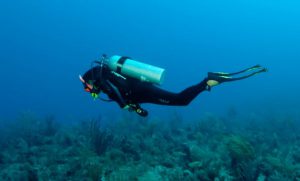 Ever see divers hover underwater horizontally or vertically effortlessly? They just seem to glide as if everything is all controlled by their thoughts alone. They exert very little energy. All they do is simply observe and enjoy the aquatic life and disturb nothing! They are one with the underwater world!
Ever see divers hover underwater horizontally or vertically effortlessly? They just seem to glide as if everything is all controlled by their thoughts alone. They exert very little energy. All they do is simply observe and enjoy the aquatic life and disturb nothing! They are one with the underwater world!
They even come back with lots of air in their tank!
Taking you on this journey! You need to understand …
Archimedes, the ancient Greek mathematician ran down the street naked shouting ‘Eureka, Eureka’ interpreted as ‘I have it, I have it!’. He had just discovered the basic principle of buoyancy which we as divers need to understand regarding the physics of scuba diving.
His principle states “that a body immersed in a fluid is buoyed up by a force (buoyant force) equal to the weight of the fluid displaced by the body”. In simpler terms… objects that are denser than the fluid it displaces will sink and objects that are not so dense than the fluid it displaces will float.
For instance, a ship will float because it has less density and a coin will sink because the it has more density.
Wondering what this has to do with divers? Here’s what you need to understand:
1) Our human body is made up of approximately 70% water. Quite amazing isn’t it? When people swim they’re buoyant so this makes them positively buoyant.
We also have body fat, muscles and even bone density.
2) Dive gear like BCD (Buoyancy Control Device), weights, wetsuit, hoodie, regulator and tank must also be taken into consideration.
3) Water has density too! When you dive in salt water, you will be more buoyant than fresh water because salt water is more dense than fresh water.
Let’s take a quick look at dive gear and why it affects our buoyancy!
We can control our buoyancy by the dive gear we choose to wear. Consider the following:
Wetsuits:
As a diver, it’s best to wear a wetsuit either shortie or full length because it not only keeps you warm but it protects you from coral and stings from jellyfish. Wetsuits are made out of foamed neoprene and wearing it creates buoyancy. Wetsuits also come in different thicknesses. The thicker your wetsuit, the more buoyancy you need to compensate for on weights… especially if the wetsuit is new.
BCD (Buoyancy Control Device):
I would best describe this as a vest type inflatable bladder. The purpose of a BCD is to help you maintain neutral buoyancy underwater as well as positive buoyancy on the surface of the water when you need to.
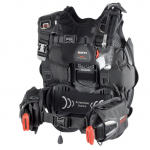

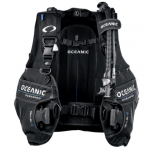
There are buttons on it which you can push to inflate air from the tank into the BCD or deflate air from the BCD. There are all kinds of BCDs ranging from light-weight foldable to wing-type BCDs to the very tailored for women.
Weights (lead):
Sadly, you do need to wear weights because it also helps to control your buoyancy. How much weights are determined by your wetsuit thickness, your body type, etc….
Caution:
If you have wear a new BCD and or a new wetsuit you will end up wearing more weights than your normal.
Good News:
The more dives you do and the more you wear that same wetsuit (thru wear and tear that same ole neoprene thins out) and your breathing control gets better because you’re more relaxed… you will lighten the weights. Yea!!!
Dive Tanks:
Even an aluminum dive tank when filled to 3000 psi of compressed air is negatively buoyant but as you use up more air during your dive and towards the end of your dive the tank starts to become positively buoyant.
Ever find yourself struggling to stay down with the dive group near the end of your dive? You’re looking down at them? Perhaps your tour guide is giving you the hand signal to come back down…
This happens when your tank doesn’t have as much air and your BCD now has too much air. Just push that deflator button attached to your BCD and release some air… this should get you back on the same depth as your dive group.
If that doesn’t work, your tour guide will assist you with extra weight. You want to remember this for your next dive… EXTRA WEIGHT!!
Now that you know all this, let’s work on what you need to do get neutrally buoyant!
1) Pre-Prep.
Has anything changed? Do you have new BCD and or new wetsuit? You will need more weights!
Try weighing your old wetsuit and your new wetsuit on a bathroom scale and you’ll see what I mean. Do the same with your new BCD..
2) Float in the water at eye level.
Practice this at the deep end in a pool.
Wear your full dive gear including weights. Remember to put the regulator in your mouth. Make sure your body is vertical in the water.
- The first thing you want to do is to deflate all the air remaining in your BCD. You do this by pushing the deflator button which is attached to the BCD.
- Hold your normal breath. You should be able to float at eye level.
- If you don’t float at eye level, you need to adjust your weights by either adding more weight or removing excess weight.
- Once you are floating at eye level, the next step is to simply exhale to slowly sink.
3) Next, let’s focus on your dive! You’re underwater now…
You’re going to be pivoting on your fin tips at the bottom of the pool. This is a very simple buoyancy control skill and will help you on your breathing control. You lay face down on the bottom of the pool and use your breathing to elevate and lower your torso.
- Fully deflate your BCD.
- Straighten and spread out both your legs and let both fin tips touch the bottom.
- Never use your arms so keep them folded in front of you. You’re working on breathing control!
- Do a test by inhaling. The point of this is to ensure there is no air left in your BCD. If you find yourself ascending, you need to get rid of that excess air by pushing that deflator button again.
- Now push that inflator button once (don’t hold it) to put a little bit of air in.
- Inhale slowly and deeply. This creates buoyancy. If you have the right amount of weights, your torso will slightly elevate while your fin tips are still touching the bottom.
- Next, you want to slowly and deeply exhale. By doing this, your torso should slowly descend and touch the bottom.
- Repeat this procedure couple more times.
4) Streamlining.
When you’re diving, tuck in anything that’s hanging loose like your regulator hoses and loose straps if you’re wearing a long weight belt. Having loose ends like this can also cause injury to the aquatic life like coral, sea fans, etc.
No only that, you also look like you know what you’re doing and feel good about it!
5) Fold your arms in front of you.
Flailing your arms not only uses energy and air but it doesn’t really help you much on your buoyancy. Keeping your arms folded can be very calming and you will be in more control of your buoyancy and your breathing.
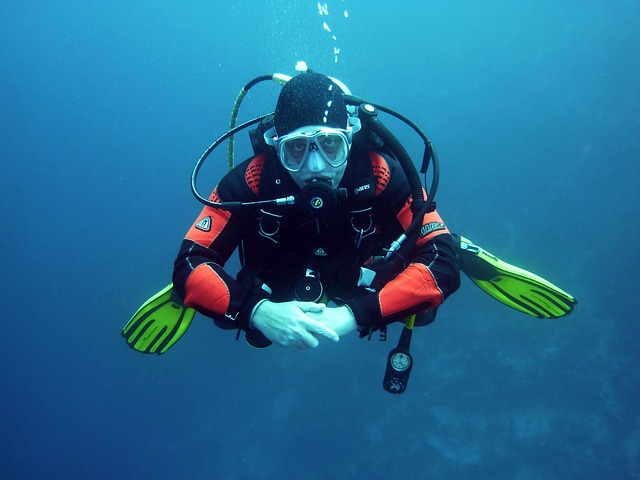
6) IMPORTANT.. IMPORTANT!
Remember this rule… always breathe continuously, deeply and slowly. Steady breathing like this helps you on your buoyancy. NEVER HOLD YOUR BREATH!! Your lungs will burst if you don’t allow air to escape.
7) Keep a record of your weights! This will make your life underwater a whole lot easier when you’re using the right amount of weights!!
I would like to hear your stories of buoyancy control. What worked for you and what didn’t? If you have any questions and comments, please put them in the comment box below.
Are you thinking about purchasing some dive gear? Check out my review on Scuba Masks!!
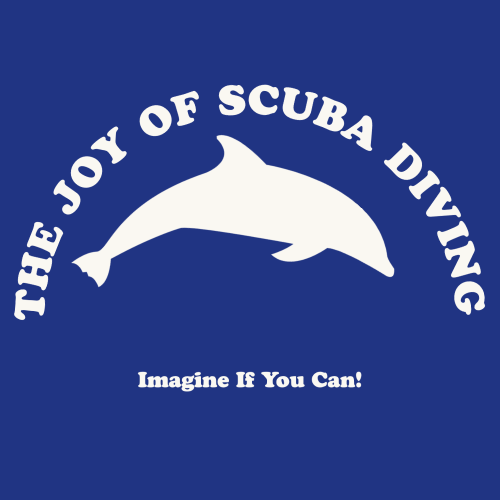
Hi there,
Thanks for creating and sharing this in depth article on buoyancy control. It is appreciated thanks.
Definately need to bookmark this article and re-read it a couple of times. I have never scuba dived but I am going to for the first time in Bali in the middle of next month.
Lot of good handy tips in this article worthy of keeping in my mind prior to the training I have to undertake before we go on a dive.
Hi Derek,
You’re welcome! Glad to hear you’re bookmarking this.. when you go to Bali and take your course whether it be recreational introduction to scuba diving or the open water dive certification, your instructor will teach you all about buoyancy control. You’ll be one step ahead…
Have fun learning to scuba dive and I really would like to hear how well your control of buoyancy underwater went!
Regards,
Monica
Good Day, Monica.
This is a very detailed account of buoyancy control. I am not a diver but I have a brother and a few friends that are. They often discuss this principle to their newbie friends.
I do listen to their diving stories, but after reading your blog I will be better able to follow along and perhaps even provide an intelligent comment.
I will mention this website to them as well. Keep up the easy to follow lessons and happy diving to you!
Paul
Hey Paul,
Thanks so much for reading my article! Buoyancy control is a popular discussion among divers .. lol… yes you will be right there in all their dive conversations for sure!!
I appreciate you mentioning my website to your brother and friends.. thank you!
Regards,
Monica
This is very helpful thank you Monica! Even though I am certified I do find I can be an air hog! Especially in the first 10 minutes while I get used to it. When I have big gaps between diving and snorkelling at the reef it does take some getting used to it again, so when possible I like to have a quick snorkel before I dive. I live at the reef but hardly get out there anymore – even for day trips… I began to think I wasn’t a very good diver,, I would make excuses to only snorkel because I wasn’t confident. I feel you have grown my confidence and got me excited about diving again. Thanks
Hi Karsha,
You’re very welcome! Thank you for your awesome comment! I’m very pleased to hear my tips were helpful for you. I can relate. There was a time too when I was using air so fast that I couldn’t even complete my dive. When I learned how to control my buoyancy more, my dives became more enjoyable. Keep up the diving and the more you do, the more comfortable you will feel and be more relaxed. You are blessed to be living by the reef…I’m sure it’s beautiful. As you keep up with your dives, I would love to hear your buoyancy stories.
Kind Regards,
Monica